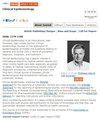Can Lipid-Lowering Drugs Reduce the Risk of Cholelithiasis? A Mendelian Randomization Study
IF 3.4
2区 医学
Q1 PUBLIC, ENVIRONMENTAL & OCCUPATIONAL HEALTH
引用次数: 0
Abstract
Background and Aims: Cholelithiasis etiology intricately involves lipid metabolism. We sought to investigate the plausible causal link between genetically proxied lipid-lowering medications—specifically HMGCR inhibitors, PCSK9 inhibitors, and NPC1L1 inhibitors—and cholelithiasis risk.Methods: Our study utilized two genetic instruments for exposure to lipid-lowering drugs. These instruments encompassed genetic variants linked to low-density lipoprotein (LDL) cholesterol within or in proximity to drug target genes, along with loci governing gene expression traits of these targets. Effect estimates were derived through Inverse-variance-weighted MR (IVW-MR) and summary-data-based MR (SMR) methods.
Results: Higher HMGCR-mediated LDL cholesterol levels (IVW-MR, OR = 2.15, 95% CI = 1.58– 2.94; P = 0.000) and increased HMGCR expression (SMR, OR = 1.19, 95% CI = 1.04– 1.37; P = 0.014) are linked to elevated cholelithiasis risk, suggesting potential benefits of HMGCR inhibition. In contrast, higher PCSK9-mediated LDL cholesterol levels (IVW-MR, OR = 0.72, 95% CI = 0.56– 0.94; P = 0.015) and increased PCSK9 expression (SMR, OR = 0.90, 95% CI = 0.82– 0.99; P = 0.035) both correlate with lower cholelithiasis risk, indicating that PCSK9 inhibition may elevate this risk. Nevertheless, no substantial link emerged between NPC1L1-mediated LDL cholesterol or NPC1L1 expression and cholelithiasis in both IVW-MR and SMR analyses.
Conclusion: This MR investigation affirms the causal link between the utilization of HMGCR inhibitors and a diminished risk of cholelithiasis. Additionally, it indicates a causal link between PCSK9 inhibitors use and increased cholelithiasis risk. However, no significant correlation was found between NPC1L1 inhibitors use and cholelithiasis risk.
Keywords: cholelithiasis, lipid-lowering drugs, Mendelian randomization analysis, HMGCR inhibitors, PCSK9 inhibitors, NPC1L1 inhibitors
降脂药能否降低胆石症风险?孟德尔随机研究
背景和目的:胆石症的病因与脂质代谢密切相关。我们试图研究基因代用降脂药物--特别是 HMGCR 抑制剂、PCSK9 抑制剂和 NPC1L1 抑制剂--与胆石症风险之间的合理因果关系:我们的研究利用两种基因工具来检测降脂药物的暴露情况。这些工具包括与药物靶基因内或邻近的低密度脂蛋白(LDL)胆固醇有关的遗传变异,以及控制这些靶基因表达特征的基因位点。通过逆方差加权磁共振(IVW-MR)和基于汇总数据的磁共振(SMR)方法得出效应估计值:结果:HMGCR介导的低密度脂蛋白胆固醇水平升高(IVW-MR,OR = 2.15,95% CI = 1.58- 2.94;P = 0.000)和 HMGCR 表达增加(SMR,OR = 1.19,95% CI = 1.04- 1.37;P = 0.014)与胆石症风险升高有关,这表明抑制 HMGCR 有潜在的益处。相反,较高的 PCSK9 介导的低密度脂蛋白胆固醇水平(IVW-MR,OR = 0.72,95% CI = 0.56- 0.94;P = 0.015)和 PCSK9 表达的增加(SMR,OR = 0.90,95% CI = 0.82- 0.99;P = 0.035)均与较低的胆石症风险相关,表明 PCSK9 抑制可能会增加这种风险。然而,在IVW-MR和SMR分析中,NPC1L1介导的低密度脂蛋白胆固醇或NPC1L1表达与胆石症之间没有出现实质性联系:这项磁共振调查证实了使用 HMGCR 抑制剂与降低胆石症风险之间的因果关系。此外,它还表明 PCSK9 抑制剂的使用与胆石症风险增加之间存在因果关系。关键词:胆石症;降脂药;孟德尔随机分析;HMGCR抑制剂;PCSK9抑制剂;NPC1L1抑制剂
本文章由计算机程序翻译,如有差异,请以英文原文为准。
求助全文
约1分钟内获得全文
求助全文
来源期刊

Clinical Epidemiology
Medicine-Epidemiology
CiteScore
6.30
自引率
5.10%
发文量
169
审稿时长
16 weeks
期刊介绍:
Clinical Epidemiology is an international, peer reviewed, open access journal. Clinical Epidemiology focuses on the application of epidemiological principles and questions relating to patients and clinical care in terms of prevention, diagnosis, prognosis, and treatment.
Clinical Epidemiology welcomes papers covering these topics in form of original research and systematic reviews.
Clinical Epidemiology has a special interest in international electronic medical patient records and other routine health care data, especially as applied to safety of medical interventions, clinical utility of diagnostic procedures, understanding short- and long-term clinical course of diseases, clinical epidemiological and biostatistical methods, and systematic reviews.
When considering submission of a paper utilizing publicly-available data, authors should ensure that such studies add significantly to the body of knowledge and that they use appropriate validated methods for identifying health outcomes.
The journal has launched special series describing existing data sources for clinical epidemiology, international health care systems and validation studies of algorithms based on databases and registries.
 求助内容:
求助内容: 应助结果提醒方式:
应助结果提醒方式:


